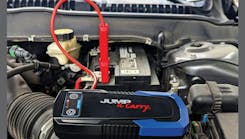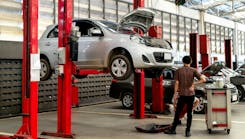The short- and long-term benefits of stocking up on must-have shop safety equipment
When it comes to shop safety, we’ve all heard the horror stories, seen the near-miss videos online, and in some cases, even witnessed firsthand the injuries that sent the technician next to us to the emergency room while doing something as routine as using a high-speed sander. And while inevitably there will always be hazards and accidents in and around the shop, many of them, both in the immediate sense of day-to-day common injuries, as well as the long-term future health of those who have spent decades in the auto repair industry, can be prevented with the proper equipment and attitude.
It’s time to drop the “it won’t happen to me” mentality, get organized, and ensure you have the right safety equipment must-haves around your shop to keep you and your team protected.
We’ll start with the obvious: PPE. There’s no excuse to not have a steady supply of consumables such as disposable gloves, ear plugs, and respiratory filters at the ready, and to constantly check the supply to ensure there’s never a shortage. But ordering a box of latex gloves for your detailer, body tech, painter and welder to all use simply won’t cut it, as each job requires a special set with different safety ratings. Take the growing EV market for instance, which requires those working at hybrid workstations to wear special sets of high-voltage gloves, which are constantly being tested and require bi-annual certifications to make sure they’re continuously safe for use.
There’s also a wide variety of other necessary PPE including safety glasses, goggles, face shields, protective body suits or coveralls, respirators, and more to account for, all of which should be easily located by anyone working in the shop. For instance, having your safety glasses conveniently located near your work area is key for more frequent usage.
While there are clear benefits to wearing and utilizing protective equipment in the short term, say to prevent a consumable like a grinding disk that, even when used properly, can still fail and fly at 4,000 rpms toward your face, there are also long-term benefits that aren’t often as thought of in the moment. For instance, working with strong chemicals can create long-lasting damage to your liver, skin, nervous system, kidneys, and eyes. We’ve even seen painters use paint thinner to clean their hands. Dust can also be a culprit, whether it’s noticeably visible, or just built up over time from sanding and grinding all day, accumulating in the lungs and respiratory systems, proving even more the reason to don a respirator daily.
There’s unfortunately a reason we don’t see as many experienced technicians still showing up for work every day, but the industry as a whole is making an active effort to take these historical learnings and better educate and equip a new workforce with the tools they need to succeed. There’s been a dedicated movement to, for example, focus on purchasing more ergonomic tools and equipment, like knee pads or creeper seats, to make repetitive movements and awkward positions less stressful on the body, which brings us to non-wearable safety equipment.
Encompassing everything from storage cabinets for flammable materials to signage and tape to create different zones around the shop, there’s a long-running list of safety staples outside of standard OSHA requirements like eye wash stations, fire extinguishers, and first aid kits that should always be in use on the premises, dependent upon the different service offerings you’re providing to your clientele. Even items like seat protectors, wheel covers, and sanitizing solutions designed to keep customers and their vehicles protected fall under the category of safety nowadays, so if you don’t know where to start in sourcing everything that’s needed for your shop, visit www.usautosupply.com.






